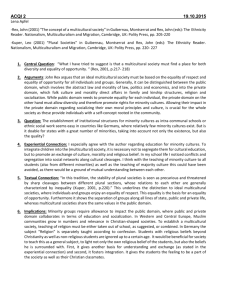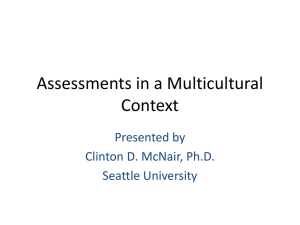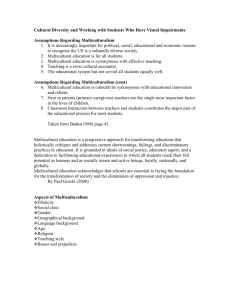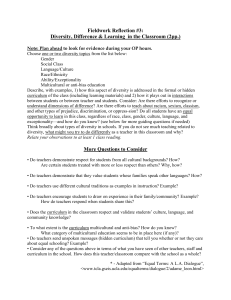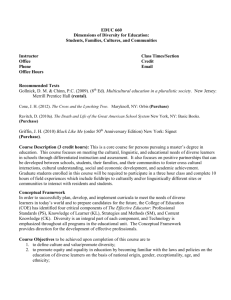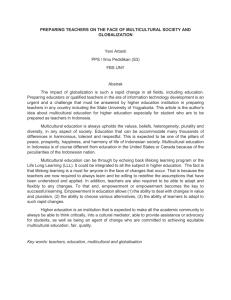How to Engage the Non-Native US History Student
advertisement
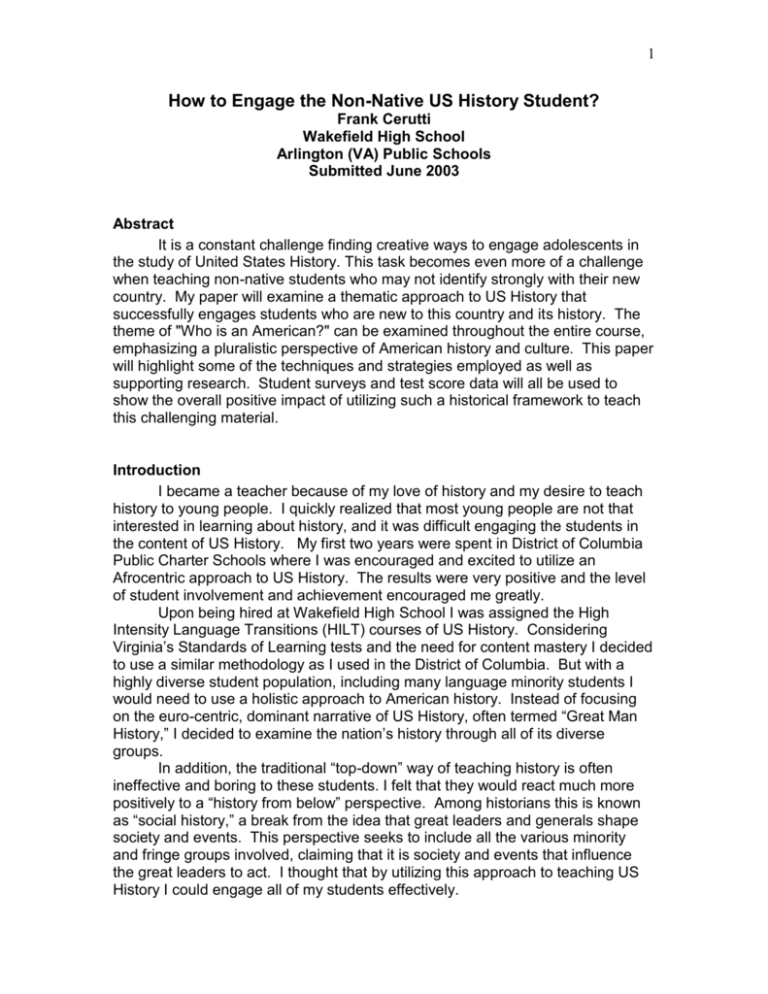
1 How to Engage the Non-Native US History Student? Frank Cerutti Wakefield High School Arlington (VA) Public Schools Submitted June 2003 Abstract It is a constant challenge finding creative ways to engage adolescents in the study of United States History. This task becomes even more of a challenge when teaching non-native students who may not identify strongly with their new country. My paper will examine a thematic approach to US History that successfully engages students who are new to this country and its history. The theme of "Who is an American?" can be examined throughout the entire course, emphasizing a pluralistic perspective of American history and culture. This paper will highlight some of the techniques and strategies employed as well as supporting research. Student surveys and test score data will all be used to show the overall positive impact of utilizing such a historical framework to teach this challenging material. Introduction I became a teacher because of my love of history and my desire to teach history to young people. I quickly realized that most young people are not that interested in learning about history, and it was difficult engaging the students in the content of US History. My first two years were spent in District of Columbia Public Charter Schools where I was encouraged and excited to utilize an Afrocentric approach to US History. The results were very positive and the level of student involvement and achievement encouraged me greatly. Upon being hired at Wakefield High School I was assigned the High Intensity Language Transitions (HILT) courses of US History. Considering Virginia’s Standards of Learning tests and the need for content mastery I decided to use a similar methodology as I used in the District of Columbia. But with a highly diverse student population, including many language minority students I would need to use a holistic approach to American history. Instead of focusing on the euro-centric, dominant narrative of US History, often termed “Great Man History,” I decided to examine the nation’s history through all of its diverse groups. In addition, the traditional “top-down” way of teaching history is often ineffective and boring to these students. I felt that they would react much more positively to a “history from below” perspective. Among historians this is known as “social history,” a break from the idea that great leaders and generals shape society and events. This perspective seeks to include all the various minority and fringe groups involved, claiming that it is society and events that influence the great leaders to act. I thought that by utilizing this approach to teaching US History I could engage all of my students effectively. 2 Methodology From the beginning of the year I strived to create a student-centered, cooperative learning environment. I prefer to be the coach on the side as much as possible, guiding the students through learning and understanding. In order to use this teaching style it is very important to create a safe, comfortable and relaxing classroom where the students can feel free to express themselves appropriately. While this approach does require more patience and effort from the teacher, I feel that the end result is highly desirable and well worth the effort. This first step is critical in creating the proper learning environment and opens doors for all other learning activities. The overall theme of the course is to continuously examine American history through the perspective of its people. For example, Native Americans are usually included in the curriculum at two or three specific instances up until 1900. Native Americans are just grafted onto the story of America at only the few times when major leaders or events demand it. So instead of only including Native Americans at the time of the French and Indian War or later during the Trail of Tears, we would examine all of American pre-colonial and colonial history as well as the early years of the country through the lens of Native Americans. This same thematic approach would be used for women, African-Americans, Asian Americans, Hispanic Americans and all of the other immigrant groups arriving in the late 19th Century Considering that many of my students are without the mental image bank that most American students possess, I consistently incorporate visual aspects into lessons and activities. To accomplish all of this I use a combination of materials from a variety of sources. I employed many materials from National Geographic, especially their excellent “Picture Pak” series of historical and cultural overhead transparencies. These detailed, comprehensive and mostly color overheads proved invaluable to me during the entire school year. The social studies department of Arlington Public Schools has taken a step forward by subscribing to and heavily endorsing the History Alive! Program. I was trained by Teachers Curriculum Institute to use their unique History Alive activities and materials. History Alive uses a series of activities such as “Act it Outs”, “Writing for Understanding” and their own specially developed interactive slide lectures. Student centered activities, cooperative learning and experiential learning are the hallmarks of History Alive and the program is well designed. The Teachers Curriculum Institute takes a progressive stance, doing a great job of highlighting women and minorities. In addition to these great materials available from National Geographic and Teachers Curriculum Institute I also used a good amount of original activities, materials and visuals that either I created for my own purposes or adapted from other teachers. I have used the immense volume of images, documents and primary source material found on the National Archives website to create some really useful activities. There is also a number of PowerPoint presentations and streaming video clips that I used regularly, again borrowing some and creating others. The materials I collected while teaching in the District 3 of Columbia formed the backbone of resources on African-Americans and African-American history, of which I drew upon heavily. Connection to the Literature There is a wealth of information on multicultural education dating back to the 1970’s. Almost all scholars agree on the need to embrace diversity and find ways to more effectively educate America’s many different students. But what is missing from the literature are clear and concise ways to accomplish this task. The disagreement and debate about multicultural education begins when examining how best to implement this lofty goal. James A. Banks is a wellrespected and prolific scholar on the topic of multicultural education, and his work was very helpful to my research. Banks is firmly in the school of cultural pluralists that promote the value of retaining cultures, not simply tolerating them or melting them down. The opposing school of multicultural education is the assimilationist school, which accepts the importance of understanding multiple beliefs, but has as its primary goal the amalgamation of all groups into the American mainstream. The goal of cultural pluralism is that ethnic groups will remain intact and that there idiosyncratic ways of knowing and acting will be respected and continued. In regards to the opposing theory, I found that Nieto arguing, that assimiliationist educational policies do not always work in the best interests of students from some minority groups. Moreover, they contend that some minorities, or substantial numbers of minority-group members, either do not want to or cannot assimilate into the American mainstream, no matter what they do; therefore these groups and individuals reject assimilation education whenever and in whatever form it is offered to them (Nieto, 1992). This telling statement confirmed my observations from teaching and my belief in a pluralistic perspective. Banks specifically comments on history education saying “teachers can help students acquire new perspectives on the development of American history and society by reforming the curriculum with the use of paradigms, perspectives, and points of view from transformative academic knowledge. Transformative academic knowledge consists of the concepts, paradigms, themes and explanations that challenge mainstream academic knowledge and that expand the historical and literary canon” (Banks, 1995). I feel that Banks and other scholars have clearly made the case for a culturally pluralistic approach to US History. In the past the curriculum has espoused the cultural values and traditions of Western Europe while excluding the contributions of America’s many minority groups. As a result, many minority children become disengaged and disaffected by US History and encounter great difficulty relating to the content. Cultural pluralism offers a means of empowerment and encourages students to take 4 ownership of a shared American identity, culture and history. I was particularly encouraged by Phillips comments, In order to change people's oppressive ways, we must learn about oppression. We must examine our responses to diversity, devoting as much effort to changing them as we devote to learning about culture. Nurturing diversity means making multicultural education a process of action, through which we as adults achieve clarity about our condition in this society and ways to change it (Phillips, 1988). Data Collection I used a variety of techniques to collect data throughout the course of the year. I kept a teacher journal and made observations and assessments through the school year. I was particularly paying attention to student attitudes, punctuality, homework completion and study habits. I was interested to see how much time, energy and effort the students were investing in my class and in their study of US History. I was also watching student performance on projects and group work. Would the students just do the required amount of work, or would they really push the creative process and put everything they could into their work. I was continuously observing and looking for evidence of Higher Order Thinking Skills, as opposed to simply memorizing content and going through the motions. In addition to a journal and observations, I was fortunate enough to have some hard data with which to draw conclusions. Every Wakefield student of US History takes the same set of benchmark objective tests at the end of each unit. Since every student in the school was taking the same test after each unit, this provided a unique opportunity to compare the performance level of my students with other teachers. The Standards of Learning Test scores would also provide similar comparative conclusions, but those scores have not yet been released. In light of this, the Objective Test Score data have proven to be the most useful set of data at my disposal. I also conducted a student survey at the end of the school year to gauge student reactions, opinions and perceptions. The survey has also been extremely useful. Results and Reflections The overwhelming results of this exciting project were tremendously positive. I feel confident that I have indeed found a way to engage the non-native student of US History through a pluralistic approach. The most telling data were the Objective Test results compiled during the entire school year. On each and every test my HILT students; almost exclusively minority language learners outperformed the mainstream students of the other classes. Not only were test scores themselves higher during the year, but the fail rate was much lower on each test. In each of my three HILT classes I would have only two to three students failing each objective benchmark test. While in the mainstream classes 5 a ratio closer to thirty percent (about 10 students each test, each class) were failing their tests. I was encouraged to see these students who were completely new to US History and not American citizens outperforming those students who grew up in this country and have been taught US History countless times from Kindergarten through High School. Students who do not pass the Objective Tests are required to retake them until they pass. I was pleased to see my HILT students readily retake any failed tests, and the final grades at the end of the year reflected this. I had an extremely low failure rate for my HILT students on their final grades. In every possible way the language minority students that I had instructed all year outperformed the rest of the Wakefield student body. My goal was to have my students keep on par with the other students, and the result was that they excelled at the course and the data prove this fact. The student survey that I conducted was only done at the end of the year and my first foray into this data collection tool. I would improve this process by additionally surveying the students in the beginning of the year, as well as at the end of the year. Regardless of this oversight, I was able to glean some valuable information from the student surveys. I tried to gauge student attitudes about history before the course and after the course. Of 52 students surveyed, 32% said they enjoyed history at the beginning of the year, with only 11% saying they loved it. But when asked what they thought about history after the course was over 48% said they enjoy and 36% said they love history. I also asked the students which group of Americans they enjoyed learning the most about and the results were a bit surprising; 30% identified with African-Americans, 21% with Native Americans, 7% picked Asian-Americans and 6% identified with American immigrants in general. I had expected more students to identify with the story and culture of Native Americans, especially as we had put American Indians in the context of indigenous peoples the world over, particularly in the Americas. It was also interesting to see only 1% of the students surveyed pick Hispanic Americans, as this was the largest ethnic group in the student body. Another surprising result of the survey was student’s ranking of teaching methods and strategies used in the classroom. I asked the students to rank the eight methods used throughout the year; Small Group Activities, Reading Assignments, Class Notes, PowerPoint/Video Presentations, Photos and Visual Images, Homework and Classwork Assignments, Students Teaching Other Students and Performance Projects. I fully expected small group activities, students teaching other students and performance projects to be ranked the highest. I was amazed to see about 23% of the students list class notes as their first choice. Homework and classwork also ranked a lot higher than I had expected. I was pleased to see about 25% of students listing photos and visual images first, as well as performance projects close behind. These seem to be the activities that students reacted most strongly to and engaged with their subjects most closely. I think that students who ranked class notes and homework high wish to remain in the relative safety of their comfort zone. That does not reflect the value, worth or potential of these activities, as it is crucial to have students occasionally step out of their comfort zone to learn. 6 Implications The implications of a teacher research project like this are great and far reaching. With high stakes and standardized testing becoming the norm nationwide, teachers and school systems can no longer afford to ignore their language minority students. Science and math are easily adapted to diverse population, as is English and literature, both of which are being successfully taught to new immigrants and minorities alike. History, however, is the most politically and culturally charged subject area found in the curriculum. No other subject plays such a great role in the socialization and Americanization of our young people. And history is often the one subject that students will admit that they cannot stand or they find completely boring. If we are to be successful in achieving both equity and excellence in American education, we must do more to address the needs of this massive student population. It does not appear that the hegemonic assimilationist methodology of indoctrinating our students is effective in teaching students to appreciate and respect American history and culture, nor does this method teach students how to think for themselves. All American students, regardless of their ethnic, linguistic or socio-economic background would benefit from a culturally pluralistic approach to US History. References Banks, J.A. (1995). “Multicultural Education and Curriculum Transformation.” Journal of Negro Education, Vol. 64, 4, 390-400. Banks, J.A., & Banks, C.A.M. (Eds.). (1993). Multicultural Education: Issues and Perspectives (2nd ed.). Boston: Allyn and Bacon. Banks, J. A. (1988). Multiethnic Education: Theory and Practice. Boston: Allyn and Bacon. Janzen, R. (1994) “Melting Pot or Mosaic?” Educational Leadership, 51(8). Nieto, S. (1992). Affirming Diversity: The Sociopolitical Context of Multicultural Education. New York: Longman. Phillips, C.B. (1988). "Nurturing Diversity For Today's Children and Tomorrow's Leaders." Young Children, 43, 2, 42-47. Pizzillo, J. J. (1983). Intercultural Studies. Dubuque, Iowa: Kendall/Hunt.

